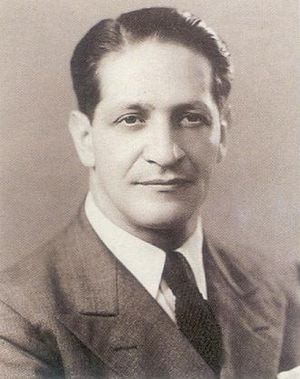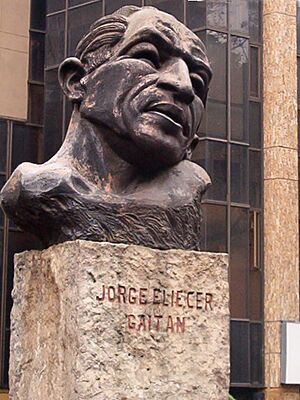Jorge Eliécer Gaitán facts for kids
Quick facts for kids
Jorge Eliécer Gaitán
|
|
|---|---|
 |
|
| 5th Minister of Labour, Health and Social Welfare of Colombia | |
| In office 8 October 1943 – 6 March 1944 |
|
| President | Alfonso López Pumarejo |
| Preceded by | Abelardo Forero Benavides |
| Succeeded by | Moisés Prieto |
| 16th Minister of National Education of Colombia | |
| In office 1 February 1940 – 15 February 1941 |
|
| President | Eduardo Santos Montejo |
| Preceded by | Alfonso Araújo Gaviria |
| Succeeded by | Guillermo Nannetti Cárdenas |
| 746th Mayor of Bogotá | |
| In office June 1936 – March 1937 |
|
| Preceded by | Francisco José Arévalo |
| Succeeded by | Gonzalo Restrepo Jaramillo |
| Member of the House of Representatives of Colombia for Cundinamarca | |
| In office 1 March 1929 – 1 February 1931 |
|
| Personal details | |
| Born |
Jorge Eliécer Gaitán Ayala
23 January 1903 Bogotá or Cucunubá or Manta, Cundinamarca, Colombia |
| Died | 9 April 1948 (aged 45) Bogotá, D.C., Colombia |
| Cause of death | Assassination |
| Political party | Colombian Liberal Party (until 1933, 1935–1948) National Leftist Revolutionary Union (1933–1935) |
| Spouse |
Amparo Jaramillo
(m. 1936) |
| Children | Gloria Gaitán |
| Alma mater | National University of Colombia (LL.D.) Sapienza University of Rome (J.D.) |
| Profession | Lawyer |
Jorge Eliécer Gaitán Ayala (born January 23, 1903 – died April 9, 1948) was an important Colombian politician. He was a leader of the Colombian Liberal Party. He served as the mayor of Bogotá from 1936 to 1937. He was also the national Education Minister from 1940 to 1941. Later, he became the Labor Minister from 1943 to 1944.
Gaitán was killed during his second campaign to become president in 1948. His death caused a huge riot called the Bogotazo. This event led to a very violent time in Colombian history known as La Violencia, which lasted for about ten years. Gaitán's ideas, called Gaitanismo, were about making society fairer for everyone.
Contents
Early Life and Education
Jorge Eliécer Gaitán was born in Bogotá, Colombia. His parents were members of the Liberal Party. Even though his family was not rich, they were part of the middle class. Gaitán grew up in a neighborhood called Egipto, where he saw a lot of poverty.
His father, Eliécer Gaitán, was a history teacher, a journalist, and sold books. He taught young Jorge about Colombian history and politics. His mother, Manuela Ayala de Gaitán, was a teacher. She taught him to read and write. She believed strongly in education and encouraged her son to study.
Gaitán started formal school at age 12. He didn't like strict rules or old-fashioned lessons. Once, he even got expelled for throwing an inkwell! In 1913, he got a scholarship to Colegio Araújo. This was a liberal school that encouraged new ideas.
In 1918, Gaitán wrote a letter to a newspaper. He said that higher education was important for everyone, especially for people who didn't have many chances. He wanted to teach subjects like hygiene in Sunday schools to help more people. Through his studies and leadership, Gaitán dreamed of becoming president to fight against unfairness in society and the economy.
He later went to the National University in Bogotá. In 1920, he helped start the University Center of Cultural Propaganda. He wanted to help workers learn more. As president of this center, Gaitán traveled around the city. He talked about social issues and the problems faced by working people. He also spoke about improving the role of women in society.
Political Career
Early Political Steps
Gaitán became active in politics in the early 1920s. He joined protests against the president at the time, Marco Fidel Suárez.
His popularity grew across the country after a strike by banana workers in Magdalena in 1928. The United Fruit Company and US officials saw the strike as a threat. The Colombian army was ordered to fire on the striking workers, causing many deaths. This event is known as the Santa Marta Massacre.
Gaitán, who was also a lawyer, bravely defended the workers' rights. He demanded that those responsible for the massacre be held accountable. People started to support Gaitán more and more. His Liberal Party won the presidential election in 1930.
In 1933, Gaitán started his own political group called "Unión Nacional Izquierdista Revolucionaria" (National Leftist Revolutionary Union), or UNIR. He did this after he had some disagreements with the Liberal Party.
Speaking to the People
Gaitán was known for his powerful and exciting speeches. Many people called him a "populist" because he spoke directly to the common people. Hundreds of thousands of workers and low-income Colombians came to hear him speak. He made promises that many people felt would make their lives better.
He often talked about two groups in Colombia: the "oligarchy" (a small group of powerful, rich people) and the "people." He said the rich were corrupt and that the common people were good and deserved a better Colombia. He made people feel strong emotions by speaking out against unfairness from both the Liberal and Conservative Parties. He promised a better future if everyone worked together.
In 1946, Gaitán explained the difference between the "political country" and the "national country." He said the "political country" was controlled by the rich and their arguments. He believed it didn't listen to the real needs of the "national country," which were ordinary citizens needing better jobs and more freedom.
Gaitán's Plans for Colombia
Gaitán had a detailed plan for Colombia's future, called the Gaitanista Program. It included his ideas for political, social, and economic changes. These plans aimed to change the Colombian system, which he believed gave too much power and wealth to a small group of rich people.
His program wanted to give more power to the government to help ordinary citizens. It encouraged people like farmers, peasants, and middle and lower-class citizens to get involved in politics. He believed that economic fairness did not exist in Colombia.
The "Plataforma de Colón" was part of his plan. It wanted to reduce the big differences in income. This would be done by protecting Colombian businesses, making taxes fairer to share wealth, supporting farming, and making public services available to everyone. The plan also suggested making education more accessible, giving land to more people, improving laws for workers' protests, and strengthening the justice system. Gaitán also wanted to create an economic union among Latin American countries.
"Plan Gaitán" was another part of his program. It focused on creating new organizations. One main idea was to give the Colombian Central Bank more power to control the financial market. This would help the bank regulate private businesses. The plan also wanted to create a special corporation to give loans for industry and farming. Gaitán's plans showed his strong belief in helping the common people and making Colombia fairer for everyone.
Later Political Career
After rejoining the Liberal Party in 1935, Gaitán became the mayor of Bogotá in June 1936. He was mayor for eight months. During this time, he tried to start many programs for education, health, and housing in the city. However, his efforts were stopped by political groups and disagreements over some of his ideas.
In 1940, Gaitán became the Minister of Education under President Eduardo Santos. He started a big campaign to teach more people to read and write. He also promoted cultural activities.
In 1945, at a big meeting of the Liberal Party, Gaitán was announced as "the people's candidate" for president. This was unusual because it happened in a public square, not behind closed doors.
In the 1946 elections, the Liberal Party lost to the Conservative Party. This happened because the Liberal Party was divided and had two different candidates, Gaitán and Gabriel Turbay.
Gaitán became the leader of the Colombian Liberal Party in 1947. His supporters won many seats in Congress. This meant the Liberal Party could have a single candidate for the 1950 elections.
Assassination
Many people believe that Jorge Eliécer Gaitán would have become president if he had not been killed on April 9, 1948. He was against violence and wanted to achieve change through elections. His assassination directly led to a period of great violence between conservatives and liberals. This violence also helped the rise of communist rebel groups. Over the next fifteen years, hundreds of thousands of people died because of the unrest that followed his death.
Gaitán's suspected killer, Juan Roa Sierra, was immediately killed by an angry crowd. So, his reasons for the assassination were never fully known. Many different people and groups have been blamed for planning the assassination. These include the government, parts of the Liberal party, and even foreign groups. However, no clear information has ever been found, and many theories still exist.
One theory says that Juan Roa Sierra was simply tired of trying to get a job from Gaitán. He had visited Gaitán's office many times before the assassination. He bought the gun two days before and the bullets the day before. On his last visit, his name was finally written down to be seen by Gaitán.
Another interesting fact is that Gaitán was murdered during the 9th Pan-American Conference in Bogotá. This meeting was led by the US Secretary of State, George Marshall. At this meeting, countries promised to fight communism in the Americas. This also led to the creation of the Organization of American States.
A young Fidel Castro, who would later become a famous leader in Cuba, was also in Bogotá at the time. He was organizing a meeting of young Latin Americans to protest the Pan American conference. Castro had an appointment to meet Gaitán later on the day of his murder. He had also met Gaitán two days earlier.
Gaitán's assassination caused a huge, violent riot known as the Bogotazo. This led to ten more years of violence, known as La Violencia, where at least 300,000 people died. Some writers say this event changed Castro's mind about whether political change could happen through elections.
The famous Colombian writer and Nobel Prize winner Gabriel García Márquez was also in Bogotá that day. He was a young law student. He arrived at the scene shortly after the shooting and saw the angry crowd kill Gaitán's suspected assassin. García Márquez wrote about this day in his book, Living to Tell the Tale.
Legacy
Because of the chaos after his death, Gaitán could not have a proper funeral. His family had to bury him in his own house. This house is now known as the Jorge Eliécer Gaitán House Museum, and his remains are still there. The violence between political parties later spread to other parts of Colombia during La Violencia.
There is a popular story about Gaitán. During a debate with a Conservative candidate for president, Gaitán asked him how he made his living. The candidate replied, "From the land." Gaitán then asked, "How did you get this land?" The candidate said, "I inherited it from my father!" This question was repeated a few times. Finally, the Conservative candidate admitted, "We took it from the Natives." Gaitán's famous reply was, "Well, we want to do the opposite: we want to give the land back to the Natives." This story shows his strong belief in helping the common people and giving them what he felt was rightfully theirs.
See also
- Jorge Eliecer Gaitan Museum
- Colombian Liberal Party
- Colombian Conservative Party
- Revolutionary Armed Forces of Colombia
 In Spanish: Jorge Eliécer Gaitán para niños
In Spanish: Jorge Eliécer Gaitán para niños


